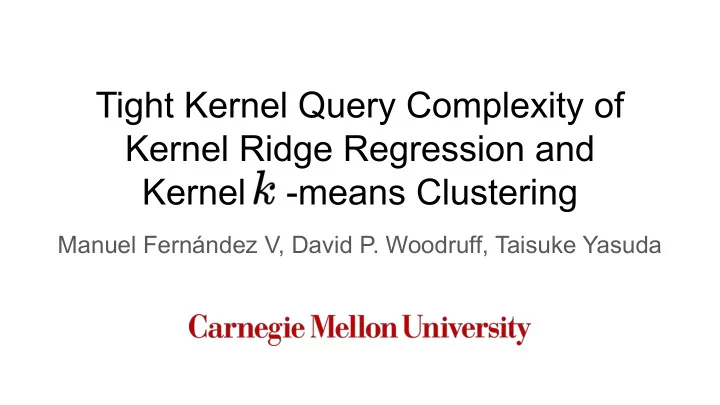

Tight Kernel Query Complexity of Kernel Ridge Regression and Kernel -means Clustering Manuel Fernández V, David P. Woodruff, Taisuke Yasuda
Kernel Method ● Many machine learning tasks can be expressed as a function of the inner product matrix of the data points (rather than the design matrix) ● Easily adapt to an algorithm for the data under a feature map through the use of a kernel
Kernel Query Complexity ● In this work, we study kernel query complexity : the number of entries of the kernel matrix read by an algorithm
Kernel Ridge Regression (KRR) ● Kernel method applied to ridge regression ● For large data sets, computing the above is prohibitively expensive ● Approximation guarantee
Query-Efficient Algorithms ● State of the art approximation algorithms have sublinear and data-dependent runtime and query complexity (Musco and Musco NeurIPS 2017, El Alaoui and Mahoney NeurIPS 2015) ● Key quantity: effective statistical dimension
Query-Efficient Algorithms Figure from Cameron Musco’s slides
Query-Efficient Algorithms Theorem (informal) There is a randomized algorithm computing a -approximate KRR solution with probability at least 2/3 makes at most kernel queries.
Is this tight?
Contribution 1: Tight Lower Bounds for KRR Theorem (informal) Any randomized algorithm computing a -approximate KRR solution with probability at least 2/3 makes at least kernel queries. ● Effective against randomized and adaptive (data-dependent) algorithms ● Tight up to logarithmic factors ● Settles an open question (El Alaoui and Mahoney NeurIPS 2015)
Contribution 1: Tight Lower Bounds for KRR Proof (sketch) ● Our hard input distribution: all ones vector for the target vector , regularization , distribution over binary matrices with effective statistical dimension and rank
Contribution 1: Tight Lower Bounds for KRR ● Data distribution for the kernel matrix:
Contribution 1: Tight Lower Bounds for KRR Lemma Any randomized algorithm for labeling the block size of a constant fraction of rows of a kernel matrix drawn from must read kernel entries. ● Proven using standard techniques
Contribution 1: Tight Lower Bounds for KRR Reduction Main Idea: one can just read off the labels of all the rows from the optimal KRR solution, and one can do this for a constant fraction of the rows from an approximate KRR solution.
Contribution 1: Tight Lower Bounds for KRR Optimal KRR solution
Contribution 1: Tight Lower Bounds for KRR Optimal KRR solution The entries are separated by a multiplicative factor.
Contribution 1: Tight Lower Bounds for KRR Approximate KRR solution ● By averaging the approximation guarantee over the coordinates, we can still distinguish the cluster sizes for a constant fraction of the coordinates
Kernel -means Clustering (KKMC) ● Kernel method applied to -means clustering ● Objective: a partition of the data set into clusters ● Minimize the cost: sum of squared distances to the nearest centroid
Contribution 2: Tight Lower Bounds for KKMC Theorem (informal) Any randomized algorithm computing a -approximate KKMC solution with probability at least 2/3 makes at least kernel queries. ● Effective against randomized and adaptive (data-dependent) algorithms ● Tight up to logarithmic factors
Contribution 2: Tight Lower Bounds for KKMC ● Similar techniques, show that a KKMC algorithm must find nonzero entries of a sparse kernel matrix ● Hard distribution is sums of standard basis vectors in
Kernel -means Clustering of Mixtures of Gaussians ● For input distributions encountered in practice, previous lower bound may be pessimistic ● We show that for a mixture of isotropic Gaussians with the dot product kernel, we can solve KKMC in only kernel queries
Contribution 3: Query-Efficient Algorithm for Mixtures of Gaussians Theorem (informal) Given a mixture of Gaussians with mean separation , there exists a randomized algorithm which returns a - approximate -means clustering solution reading kernel queries with probability at least 2/3.
Contribution 3: Query-Efficient Algorithm for Mixtures of Gaussians Main Idea: Johnson-Lindenstrauss Lemma ● Dimension reduction by multiplying data set by a matrix of zero mean Gaussians ● Implemented with few kernel queries since inner products are precomputed
Recommend
More recommend